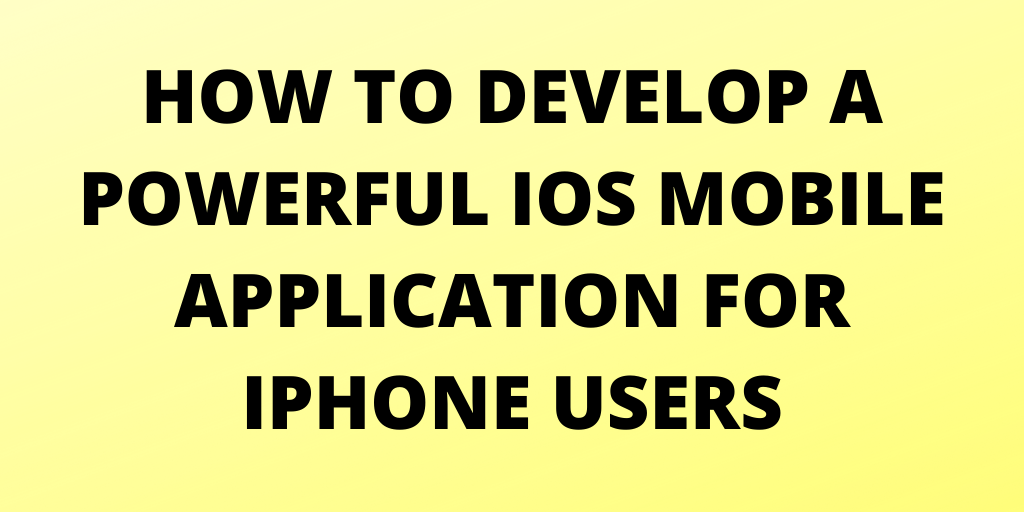How To Develop A Powerful iOS Mobile Application For iPhone Users
There are several important steps to develop a powerful iOS mobile app for iPhone users. Building a custom iPhone app from scratch can be a long, complicated, and highly technical process. Of course, you have to carefully plan, code, test, and deploy your product. After all of this, you still need to craft a professional marketing strategy to bring your program to the market. Therefore, tech-savvy app enthusiasts, such as yourself, must follow a comprehensive, structured process throughout development. This way, you can maximize quality, reduce risks, and streamline your delivery pipeline. To help you get started, read on to learn about how to develop a powerful iOS mobile application for iPhone users.
Outline Your Application’s Concept
First and foremost, outline the initial concept of your iOS mobile application. You must have a clear understanding of your product’s functionality, features, and core elements. In addition, you should have professionally drafted user interface (UI) sketches, navigation maps, and screen flow diagrams. To help you effectively organize this process, stick with application design documents. This will keep you focused, attentive, and engaged throughout the build process. In addition, you should dram multiple thumbnail sketches to represent every screen in your application. Certainly, outlining your app’s concept is essential to develop a powerful iOS mobile application.
Define Your Audience
Next, define who your iOS mobile application’s audience will be. Start off by looking at current competitors in your mobile app genre. This will help to refine your unique selling proposition (USP), identify emerging market trends, and uncover potential threats. Then, choose specific demographics that you want to target. These include anything from age, education level, or gender. After outlining this data, begin to evaluate the psychographics of your audience. With a deep understanding of your target users, you can better focus your messaging, direct your marketing, and allocate your advertising budget. This way, you can maximize recognition and overhaul your branding. Surely, target audience definition is an important step to develop an iOS mobile application for iPhone users.
Set Up Your Development Environment
Now, you are ready to set up your iOS mobile application development environment. There are several advanced programming tools and solutions that can help you create a powerful app. For example, many teams use DevOps tools to accelerate product delivery, optimize resource utilization, and streamline issue resolution. Visit https://jfrog.com/devops-tools/ to learn more about using DevOps in your development pipeline. This way, you can maximize speed, agility, and quality while building. Simultaneously, these robust tools drive greater availability, innovation, and scalability across your pipeline. Indeed, establishing your development environment with the top tools and resources is essential to build a powerful iOS mobile app.
Learn A Programming Language
With all your development tools and resources in place, begin learning a programming language for iOS mobile app engineering. Historically, Objective-C was one of the most popular frameworks for iPhone app development. This object-oriented, general-purpose language has always been supported by Apple. However, many modern app developers are learning how to write in Swift. Of course, this compiled, multi-paradigm architecture is faster, safer, and more readable compared to many other languages. Simultaneously, Swift is less error-prone, offers interactive coding, and functions as an open-source structure. Absolutely, learning a programming language is vital to successfully build an iOS app for iPhone users.
Develop App Prototypes
At this point, it is time to begin developing prototypes for your iOS mobile application. Start off by creating working sketches of what each of your primary screens will look like. Then, focus on transforming these basic sketches into wireframes. Essentially, these are simple, low-fidelity outlines of your iOS application. Once these are professionally constructed, you can readily turn these wireframes into advanced prototypes. Following these procedures, you can eliminate development miscommunications, reduce programming time, and maximize stakeholder confidence. Of course, this allows you to improve quality, enhance collaboration, and drive better user feedback. Definitely, developing advanced app prototypes is vital to effectively develop an iOS mobile application.
There are a few important steps to get started with iOS mobile app development. First off, outline the core concept of your application. Next, define who your audience will be based on demographic data and purchase information. Once you have done so, configure your development environment. Now, you are ready to learn a programming language, such as Objective-C or Swift. At this point, it is time to begin developing working prototypes for your application. Follow the points highlighted above to learn about how to develop a powerful iOS mobile application for iPhone users.


